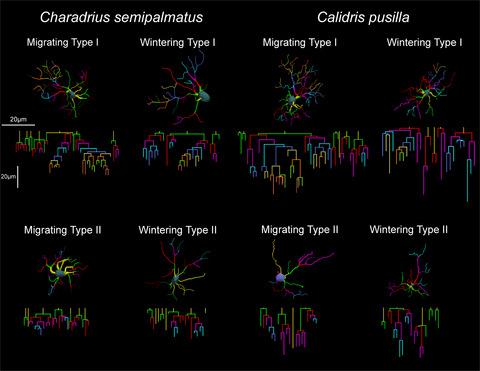当前位置:
X-MOL 学术
›
Eur. J. Nerosci.
›
论文详情
Our official English website, www.x-mol.net, welcomes your feedback! (Note: you will need to create a separate account there.)
Contrasting migratory journeys and changes in hippocampal astrocyte morphology in shorebirds
European Journal of Neroscience ( IF 3.4 ) Pub Date : 2020-05-13 , DOI: 10.1111/ejn.14781 Ediely Pereira Henrique 1 , Marcus Augusto de Oliveira 2 , Dario Carvalho Paulo 2 , Patrick Douglas Corrêa Pereira 1 , Cleyssian Dias 3 , Lucas Silva de Siqueira 1 , Camila Mendes de Lima 2 , Diego de Almeida Miranda 1 , Péricles Sena do Rego 4 , Juliana Araripe 4 , Mauro André Damasceno de Melo 1 , Daniel Guerreiro Diniz 2, 5 , Nara Gyzely de Morais Magalhães 1 , David Francis Sherry 6 , Cristovam Wanderley Picanço Diniz 2 , Cristovam Guerreiro Diniz 1
European Journal of Neroscience ( IF 3.4 ) Pub Date : 2020-05-13 , DOI: 10.1111/ejn.14781 Ediely Pereira Henrique 1 , Marcus Augusto de Oliveira 2 , Dario Carvalho Paulo 2 , Patrick Douglas Corrêa Pereira 1 , Cleyssian Dias 3 , Lucas Silva de Siqueira 1 , Camila Mendes de Lima 2 , Diego de Almeida Miranda 1 , Péricles Sena do Rego 4 , Juliana Araripe 4 , Mauro André Damasceno de Melo 1 , Daniel Guerreiro Diniz 2, 5 , Nara Gyzely de Morais Magalhães 1 , David Francis Sherry 6 , Cristovam Wanderley Picanço Diniz 2 , Cristovam Guerreiro Diniz 1
Affiliation

|
Semipalmated sandpiper (Calidris pusilla) migration to the Southern Hemisphere includes a 5-day non-stop flight over the Atlantic Ocean, whereas semipalmated plover (Charadrius semipalmatus) migration, to the same area, is largely over land, with stopovers for feeding and rest. We compared the number and 3D morphology of hippocampal astrocytes of Ch. semipalmatus before and after autumnal migration with those of C. pusilla to test the hypothesis that the contrasting migratory flights of these species could differentially shape hippocampal astrocyte number and morphology. We captured individuals from both species in the Bay of Fundy (Canada) and in the coastal region of Bragança (Brazil) and processed their brains for selective GFAP immunolabeling of astrocytes. Hierarchical cluster analysis of astrocyte morphological features distinguished two families of morphological phenotypes, named type I and type II, which were differentially affected after migratory flights. Stereological counts of hippocampal astrocytes demonstrated that the number of astrocytes decreased significantly in C. pusilla, but did not change in Ch. semipalmatus. In addition, C. pusilla and Ch. semipalmatus hippocampal astrocyte morphological features were differentially affected after autumnal migration. We evaluated whether astrocyte morphometric variables were influenced by phylogenetic differences between C. pusilla and Ch. semipalmatus, using phylogenetically independent contrast approach, and phylogenetic trees generated by nuclear and mitochondrial markers. Our findings suggest that phylogenetic differences do not explain the results and that contrasting long-distance migratory flights shape plasticity of type I and type II astrocytes in different ways, which may imply distinct physiological roles for these cells.
中文翻译:

滨鸟迁徙过程和海马星形胶质细胞形态变化的对比
半掌鹬 ( Calidris pusilla ) 迁徙到南半球包括在大西洋上空的 5 天直飞,而半掌鹬 ( Charadrius semipalmatus ) 迁徙到同一地区主要是在陆地上,中途停留觅食和休息. 我们比较了Ch海马星形胶质细胞的数量和 3D 形态。Semipalmatus在秋季迁徙前后与C. pusilla 的那些测试这些物种的对比迁移飞行可以差异地塑造海马星形胶质细胞数量和形态的假设。我们在芬迪湾(加拿大)和布拉干萨(巴西)沿海地区捕获了这两个物种的个体,并对他们的大脑进行了处理,以对星形胶质细胞进行选择性 GFAP 免疫标记。星形胶质细胞形态特征的分层聚类分析区分了两种形态表型家族,称为 I 型和 II 型,它们在迁徙飞行后受到不同的影响。海马星形胶质细胞的体视计数表明,C. pusilla中星形胶质细胞的数量显着减少,但在Ch 中没有变化。半掌肌。此外,C. pusilla和通道 秋迁后半掌状海马星形胶质细胞形态特征受到不同影响。我们评估了星形胶质细胞形态测量变量是否受C. pusilla和Ch之间系统发育差异的影响。semipalmatus,使用系统发育独立的对比方法,以及由核和线粒体标记生成的系统发育树。我们的研究结果表明,系统发育差异并不能解释结果,对比长距离迁徙飞行以不同方式塑造 I 型和 II 型星形胶质细胞的可塑性,这可能暗示这些细胞具有不同的生理作用。
更新日期:2020-05-13
中文翻译:

滨鸟迁徙过程和海马星形胶质细胞形态变化的对比
半掌鹬 ( Calidris pusilla ) 迁徙到南半球包括在大西洋上空的 5 天直飞,而半掌鹬 ( Charadrius semipalmatus ) 迁徙到同一地区主要是在陆地上,中途停留觅食和休息. 我们比较了Ch海马星形胶质细胞的数量和 3D 形态。Semipalmatus在秋季迁徙前后与C. pusilla 的那些测试这些物种的对比迁移飞行可以差异地塑造海马星形胶质细胞数量和形态的假设。我们在芬迪湾(加拿大)和布拉干萨(巴西)沿海地区捕获了这两个物种的个体,并对他们的大脑进行了处理,以对星形胶质细胞进行选择性 GFAP 免疫标记。星形胶质细胞形态特征的分层聚类分析区分了两种形态表型家族,称为 I 型和 II 型,它们在迁徙飞行后受到不同的影响。海马星形胶质细胞的体视计数表明,C. pusilla中星形胶质细胞的数量显着减少,但在Ch 中没有变化。半掌肌。此外,C. pusilla和通道 秋迁后半掌状海马星形胶质细胞形态特征受到不同影响。我们评估了星形胶质细胞形态测量变量是否受C. pusilla和Ch之间系统发育差异的影响。semipalmatus,使用系统发育独立的对比方法,以及由核和线粒体标记生成的系统发育树。我们的研究结果表明,系统发育差异并不能解释结果,对比长距离迁徙飞行以不同方式塑造 I 型和 II 型星形胶质细胞的可塑性,这可能暗示这些细胞具有不同的生理作用。



























 京公网安备 11010802027423号
京公网安备 11010802027423号